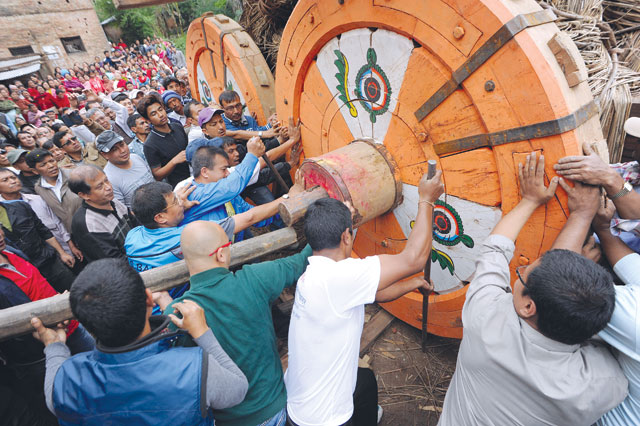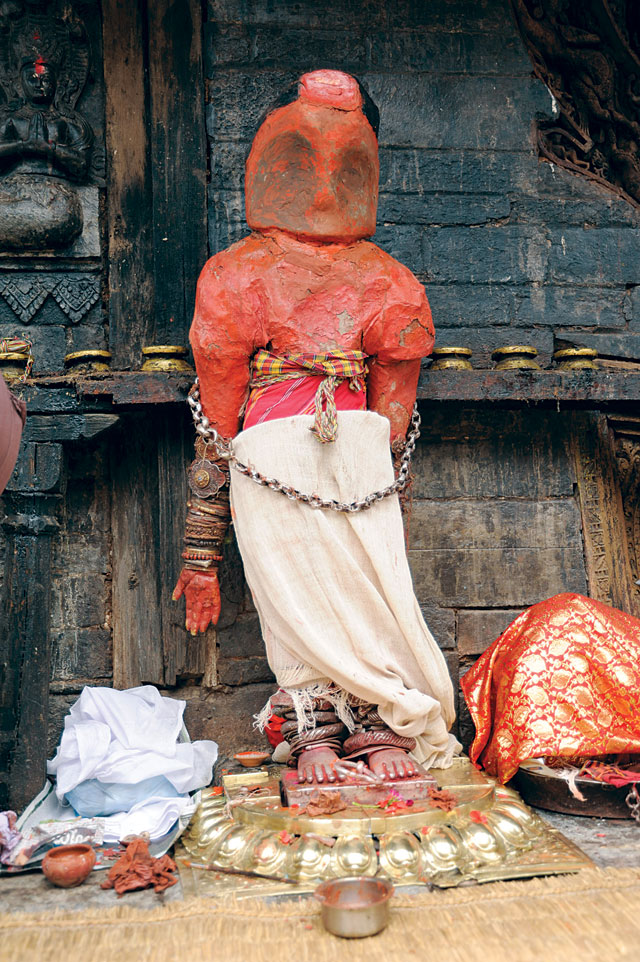In-between Science and Rumors.

Manab haru ko bikriti ko karan yesto bhayeko ho” (It’s all because of man’s sins on earth that the earthquake has happened) said my fufu baje at dinner a few weeks back. She just threw a random verdict on our plates and soon I was shouting on top of my voice, trying to make her see my point. But she wouldn’t agree. I would say it was the tectonic plates and she would say, “You are getting stubborn, I am just saying that this was God replying us, to our sins.” And I would mumble under my voice, “It’s not God.” Most people do actually think that it was a warning from Gods.
Here in Nepal, myths twist and turn, logic softens to beliefs and rumors find ways. The Bunga Dya Jatra takes place every twelve years. It was due to complete a route back to Bungamti after being wheeled down from Bungmati to visit Patan and from there to Jawalakhel now. Currently, it resides just a little further from the place itself in Chyasikot, Bhaisipati. After the ghastly earthquake on April 25, the Jatra is on hold for an uncertain period. But rumors are arife: the earthquake was a result of undisciplined rituals performed during the preparation of the Jatra. People even believe that the 12-year Machhindranath Jatra has always posed an obstacle in the country.

The Jatra had kicked off with much enthusiasm on 22 April, people pulled on the ropes with much gusto. There were people who came down to Bungmati to just have one glimpse of the Red God residing in the 32-foot chariot. The red ribbon tied to the gajur of the chariot wavered to the wind while people rejoiced and shouted in frenzied excitement. Woman danced to the beat of the Nya khin: baja and up on the terrace people wallowed in the celebration of the jatra. But after that fateful Saturday, everything fell silent.
Bungmati now sleeps on a bed of rubble while the families living in the place live under tarpaulin tents and bamboo houses. With people still struggling to come to terms with the transition made by the earthquake, the chariot now stands quietly on the way to Bungmati. But should you believe, that this was the wrath of the God and not nature, what guarantee does this give that all those who sinned are now dead. The truth is: this was a much foreseen earthquake although nobody assumed that it would be this devastating and quick.
Bungmati after the quake now seems ghostly, the earthquake has ravaged the look of the traditional Newar Village. Walking above the house of rubbles, I turn to a makeshift bamboo house of the Bunga dya’s pujari. The ground is barren and dusty and the room is just a narrow path. And I can hear the fidgety noise from behind the other bamboo wall.
And after a while, I pull myself together and croak my question, “Rumor has it that the earthquake was the result of the non ritualistic performance in Bungmati. Do you agree with this?”
“You are a student right? So, do you believe in this? These customs and rituals are set by us in a communal agreement. God didn’t ask us to do anything. It’s not God who made the ground tremor, this was the nature. But yes, we do believe that when we don’t fulfill the rituals properly it affects us in some ways but it’s usually fever. The one who is to be blamed suffers. Not everyone,” answers Kapil Bajracharya. Although a pujari, Bajracharya is a man of knowledge. He seems to know where to draw lines between our culture and science. Unlike my fufu baje who was confident that it wasn’t the wrath of God that had befallen us but nature itself that had to go through a metamorphosis.
 “The Rato Machhindranath temple also has fallen into rubble but would you say it was because God didn’t want to reside in the place. But what can you do if a place more than 200 years old is decaying from inside? If you don’t maintain things it’s obvious that they will perish. It was the same thing with the temple. We just have to learn to work together now to overcome this devastation,” says Bajracharya.
“The Rato Machhindranath temple also has fallen into rubble but would you say it was because God didn’t want to reside in the place. But what can you do if a place more than 200 years old is decaying from inside? If you don’t maintain things it’s obvious that they will perish. It was the same thing with the temple. We just have to learn to work together now to overcome this devastation,” says Bajracharya.
When I ask him if they have figured a date to start pulling the chariot back home again, he replies,“ We are trying to consult with the Guthi Sansthan and the Jyapu Samaj to come up with a date to complete the Jatra. We cannot go on like this forever. We will need to take a step soon and before Dashain.”
For Nepal, this is not the first disaster we have faced. There have been times, when the chariot has taken a detour because of setbacks from the nature and sometimes from accidents. Things have fallen apart before but it’s in times like these that we have to mutually understand the situation to fix the problem. Giving space to such blurred lines of belief will only play a blame game on us that will only delay the Jatra more. We believe, the chariot will soon be ready to be wheeled down again and we hope that even after the tremors, the excitement of roaming Rato Machhindranath to Patan and back to Bungmati will heal the wounds from the tragedy.
But had Gods started giving warnings to us from before, wouldn’t life be easier. I think I just found myself a pointer against my fufu baje’s argument.
The Story behind the Jatra
Years ago, a Maji (fishermen) family in Kamrupa Kamakchya gave birth to Avalokiteshwor (Karunamaya). Avalokiteshwor was a kind man and his budding friendship with Minpa Siddha helped him attain enlightenment. His knowledge later gave him the power to die and reincarnate in any clan that would deserve his knowledge. Avalokiteshwor then decided to be born in the Yakshakul: the blood thirsty demons that lusted for sex and alcohol.
And so he did. He became the beloved son of Yaksha Raja Sashi. Playful and compassionate the little Avalokiteshwor(Karunamaya) swooned the heart of every demon.
Here is where the story of Gorakhnatha and the Rain God: Karunamaya entwines.
One day, the ferocious Yaksha, father of Karunamaya experienced an excruciating pain in the stomach. He called the vaidya to treat him but even the greatest of vaidyas fail to cure his pain. It is in this hour, the three sowers of the Rain God arrive in the Palace with a sly solution they had conspired. “If you can save me, I will give you whatever you seek,” said the Yaksha.
 Bandu Dutta Acharya then asked the serpent King Karkotak Maharaj who had previously sneaked inside the stomach of the Yaksha according to their wired plan to impress the Yaksha (who otherwise wouldn’t have let them enter the palace) to come out. Pleased with the medication that was hoaxed, the Yaksha promised to give them anything that they wished for. King Narendra Dev, Bandu Dutta Acharya and the Lalit farmer together reply, “We would want to take your son to Kathmandu Valley.” The three sowers were desperate to get rid of the despair Kathmandu was facing due to the drought Gorakhnatha caused. The prophecy predicted that if Gorakhnatha would meet his teacher Karunamaya, he would free the serpents he sat above and bring rain and rice back to Kathmandu.
Bandu Dutta Acharya then asked the serpent King Karkotak Maharaj who had previously sneaked inside the stomach of the Yaksha according to their wired plan to impress the Yaksha (who otherwise wouldn’t have let them enter the palace) to come out. Pleased with the medication that was hoaxed, the Yaksha promised to give them anything that they wished for. King Narendra Dev, Bandu Dutta Acharya and the Lalit farmer together reply, “We would want to take your son to Kathmandu Valley.” The three sowers were desperate to get rid of the despair Kathmandu was facing due to the drought Gorakhnatha caused. The prophecy predicted that if Gorakhnatha would meet his teacher Karunamaya, he would free the serpents he sat above and bring rain and rice back to Kathmandu.
Enraged with the answer the Yaksha forbid the three to enter the palace and locked Karunamaya inside the palace in a wrathful descent. In the darkness of the night, Karunamaya’s mother spread her long hair in the doorway with her legs stretched wide to block the entrance of the door.
But faraway, Bandu Dutta Acharya conjured magic to slowly haul Karunamaya towards an empty vessel. Guised as a bee Karunamaya (to stay invisible to his mother) flew to the vessel for the King to trap him with a cover. But as they prepared to leave, the infuriated Yakshas came running to rescue their son. With no weapons to defeat them, the three called upon four Bhairavs (protector deities) to protect Karunamaya from his own family.
As they trod to Kathmandu, they struggled and whizzed through many obstacles however, upon their arrival in Patan, the three again argued over where to bestow Karunamaya. They finally divided six months each for Patan and Bungmati.
For years, after every 6 months Karunamaya returned to Bungmati from where he was close to his home but he would be transferred back to Patan prior to the beginning of the year again. It was only later that it became a Jatra. Eventually, to make things easier the chariot was built and wheeled around for every 11 years inside Patan and in the 12th year the chariot would be wheeled down from Bungmati.
Today, the four wheels of Bhairav represent the four Bhairavs in the story and the two snake ridges represent the Karkotak Maharaj who had helped the three sowers to bring Karunamaya to Kathmandu. The 32-foot Chariot symbolizes the 32 attributes of the compassionate Karunamaya.
A myth that goes around with the story is that the chariot when being pulled down from Bungmati upon reaching Jawalakhel should hush down any noises or beating of drums because it is still believed that Karunamaya’s mother live among the trees and if she happens to wake up she will try to take her son
back home.









